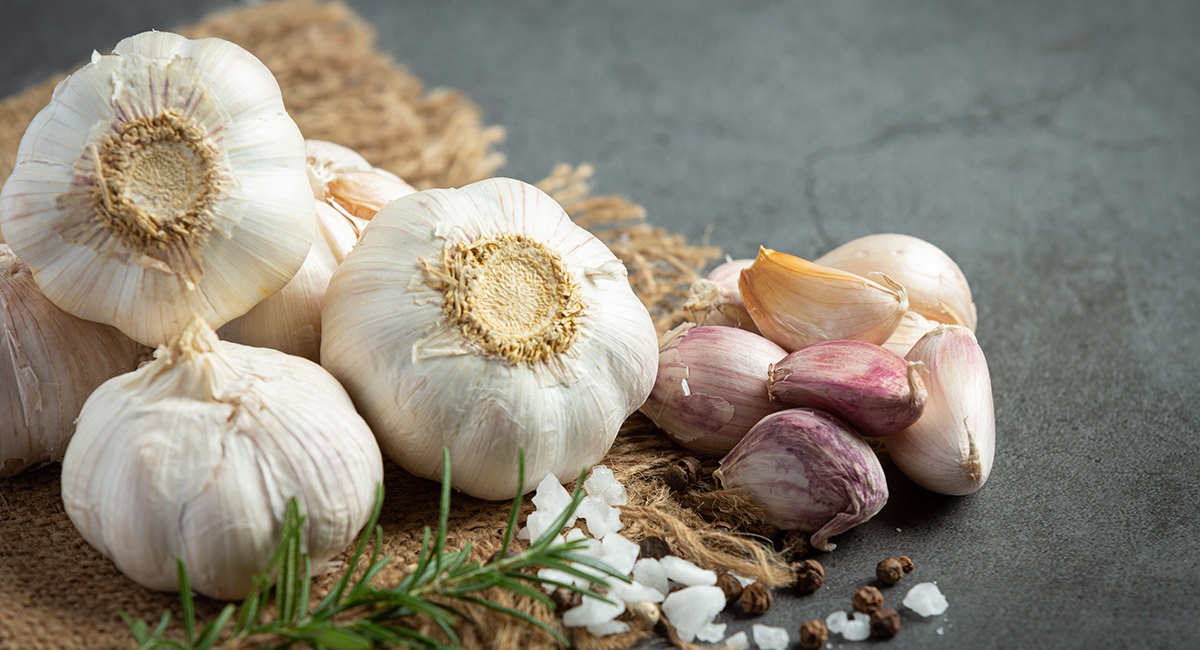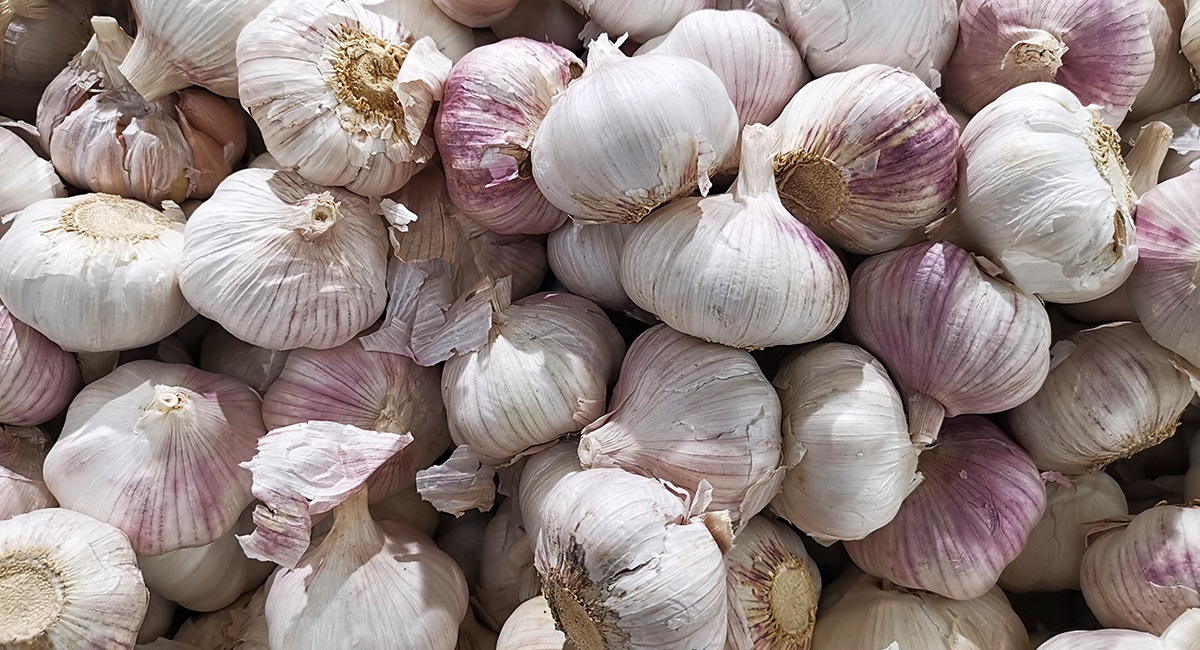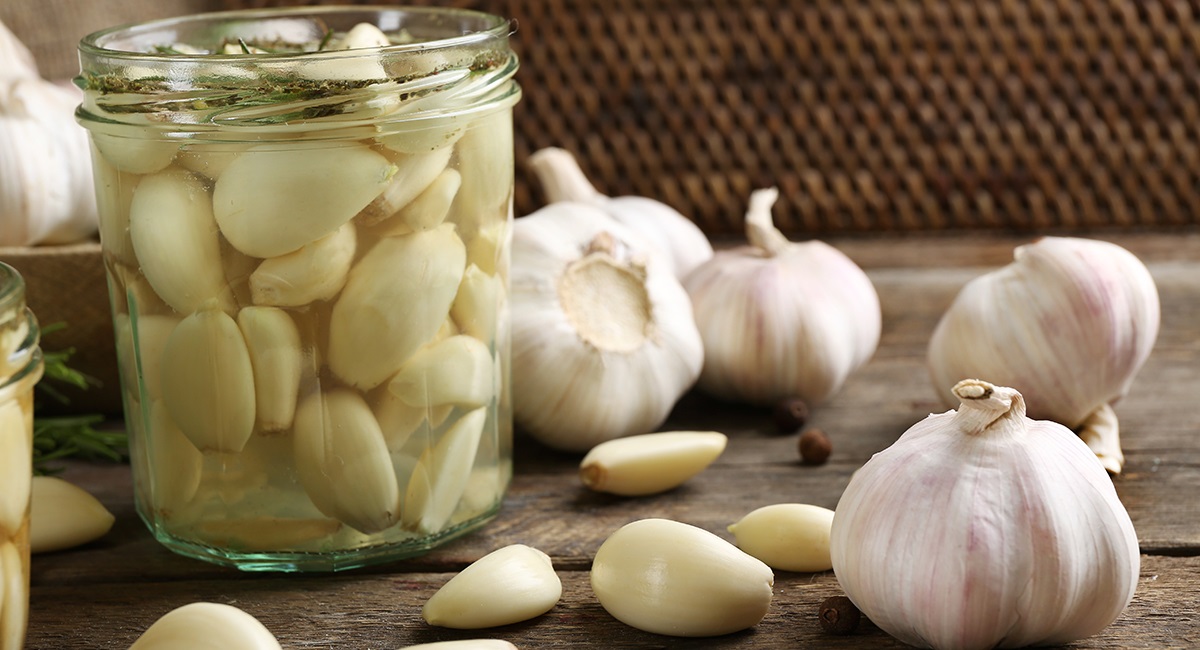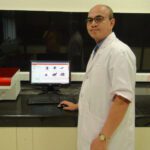Allium sativum L., commonly known as garlic and a perennial bulbous plant belonging to the Liliaceae family, is called Rasona in Sanskrit and Lahasun in Hindi. Garlic is a multiple or compound bulb consisting of 10-20 bulblets or segments called cloves, which are covered by a parchment membrane. Garlic is generally cultivated in loose, well-drained soils in sunny areas. Sandy loam and silty loam soils are best suited for garlic cultivation. Allicin is a colorless oil with low water solubility.
Phytoconstituents in Garlic cloves
The essential oil obtained from the bulbs contains allicin, diallyl disulfide, allyl propyl disulfide, and other sulfur compounds. Allicin, is one of the more than thirty sulfur compounds present in garlic. Garlic contains approximately 33 sulfur compounds (aliin, allicin, ajoene, allylpropyl disulfide, diallyl trisulfide, s-allylcysteine, S-allylmercaptocysteine, and others), several enzymes (allinase, peroxidases, myrosinase, and others), 17 amino acids (arginine and others), and minerals (selenium, germanium, tellurium, and other trace minerals). Garlic is used universally as a flavoring agent, traditional medicine, and a functional food to enhance physical and mental health.
How Allicin is produced in garlic?
Allicin is not present as such in garlic, but it is synthesized since alliin and alliinase an enzyme found in garlic are present in different microcompartments in garlic plant cells as a defence mechanism against invading pathogens, allicin is absent from raw, uncut garlic. Crushing garlic bulbs damages the thin membrane that separates these microcompartments, exposing the substrate alliin to the enzyme alliinase and causing the formation of allicin. The alliinase is permanently destroyed at acidic pH values, which accounts for the absence of allicin in the human body after ingestion.

Antimicrobial potential of Allicin
In 1858, Pasteur noted garlic’s antibacterial activity, and it was used as an antiseptic to prevent gangrene during World War I and World War II. Allicin possesses antimicrobial activity as it alters the free amino acid L-cysteine through the formation of allyl-disulfide species and Allicin has demonstrated a preference for targeting the thiol-containing proteins and/or enzymes in microorganisms by disrupting metabolic pathways and capable of controlling several genes necessary for the pathogenicity of microbes. As a result, it is projected that using allicin in combination with other antimicrobials could be a very useful weapon against infectious diseases. Allicin shows dose-dependent antimicrobial activity.
General medicinal benefits of Garlic cloves
Garlic has strong antioxidant properties, and it has been suggested that garlic can prevent cardiovascular disease, inhibit platelet aggregation, and thrombus formation, prevent cancer, diseases associated with cerebral aging, arthritis, cataract formation, and rejuvenate skin, improve blood circulation and energy levels. Garlic juice is used in Cough medicines, and it helps to alleviate asthma.

Ayurvedic formulations containing Garlic as an ingredient
There are different Ayurvedic formulations for which garlic is the main ingredient due to its beneficial properties, Lasunadi Vati is formulated to help in the treatment of digestive disorders such as indigestion, loss of appetite, and vomiting and it helps to improve the digestive function of the body. Lasunadi Ghrita is used as medicine and also in a preparatory procedure called panchakarma for the treatment of abdominal distention, neurological conditions, abdominal colic, and such Vata diseases. Vacha Lasunadi Thailam is an Ayurvedic herbal oil used to support the treatment of ear problems such as infection or external injury. It is used for head massages and as ear drops. It balances both Vata and Kapha Dosha.
Antimalarial activity of Allicin
Allicin, a cysteine protease inhibitor found in freshly crushed garlic cloves, dramatically decreases sporozoite infectivity and has previously been studied for its powerful antimalarial effect. At higher doses in eukaryotes, allicin can induce apoptosis or necrosis, whereas lower, biocompatible amounts can modulate the activity of redox-sensitive proteins and affect cellular signaling. Allicin has more bacteriostatic properties than bactericidal.

There are different varieties of Garlic Cultivated in India:
| Varieties | Region |
| Agrifound White (G-41) | Madhya Pradesh and Maharashtra |
| Yamuna Safed (G-1) | All India |
| Yamuna Safed-2 (G-50) | Northern India |
| Yamuna Safed-3 (G-282) | Chhattisgarh, Gujarat, Haryana, Madhya Pradesh, Maharashtra, Punjab, Rajasthan, and Uttar Pradesh |
| Yamuna Safed-4 (G-323) | North and Central India |
| Yamuna Safed-5 (G-189) | Andaman and Nicobar Island, Arunachal Pradesh, Bihar, Delhi Gujarat, Haryana, Jharkhand, Manipur, Meghalaya, Mizoram, Nagaland, Punjab, Rajasthan, Sikkim, Tarai region of Uttar Pradesh, Tripura and Uttarakhand |
| Godavari | Maharashtra |
| Shweta | Maharashtra |
| Phule Baswant | Madhya Pradesh and Maharashtra |
| GG 4 | Gujarat and Maharashtra |
| Ooty 1 | Tamil Nadu |
| VL Garlic 1 | Bihar, Himachal Pradesh, Jammu & Kashmir, Punjab, Uttarakhand, and Uttar Pradesh |
| VL Lahsun 2 | Himachal Pradesh, Jammu & Kashmir, and Uttarakhand |
| Agrifound Parvati | Hills of Himachal Pradesh, Uttarakhand, Jammu & Kashmir, and high altitudes of Northeastern states like Sikkim etc. |
| Agrifound Parvati-2 (G-408) | Hills of Himachal Pradesh, Uttarakhand, Jammu & Kashmir, and high altitudes of Northeastern states like Sikkim etc. |
Note: Table data taken from ICAR Directorate of Onion and Garlic Research website
Allicin is a cure for Cancer
Attaching alliinase via antibodies against cancer cells successfully showed a promising proof-of-principle.
Allicin in vasodilation
It has been demonstrated that allicin is probably the major active ingredient in garlic that gives rise to the vasodilation effect. It is suggested that the power of allicin in inhibiting calcium movements may bring vasodilation in a way like calcium channel blockers.
Antioxidant activity of Allicin
Allicin helps to protect cells against oxidative stress by inducing the generation of antioxidant products, thereby reducing cytotoxic substances, and scavenging free radicals. Allicin reacts with thiol-possessing enzymes to work as an efficient antioxidant. Indeed, allicin antioxidant properties can be explained in terms of hydroxyl and superoxide radical inhibition. Allicin also plays a crucial role as a nitric oxide (NO) formation inhibitor.
Inhibition of Enzymes by Allicin
Allicin inhibits urease, papain, and amylase.
Plant Disease Control by Allicin
Allicin effectively controlled seed-borne Alternaria spp. in carrots, Phytophthora leaf blight of tomato, and tuber blight of potato as well as Magnaporthe on rice and downy mildew of Arabidopsis.

Inhibition of Toxin production by Allicin in bacteria
In a study, it was proved that sub-inhibitory concentrations of allicin decreased the production of α-toxin in both methicillin-sensitive Staphylococcus aureus (MSSA) and methicillin-resistant Staphylococcus aureus (MRSA) in a dose-dependent manner.
Detection and Quantification of Allicin
High-performance liquid chromatography is used for the quantification and detection of allicin as it produces thiosulfinates, which are easier to detect. Cultivator Phyto Lab. Pvt. Ltd. is a well-equipped laboratory with sophisticated instruments like HPLC, with which proficient testing of allicin can be done.
Authors

Dr. Sanjoy Gupta (Ph.D)
Senior Officer- Training and Capacity Building
Dr. Sanjoy Gupta is a seasoned researcher with 13 years of experience across plant biotechnology, health science, nutrition, phytoplankton, and botanical studies. He has conducted research at reputed institutions like CSIR IIP, BSI, NIOT, and Cultivator Natural Products. With over a dozen published articles in national/international journals and thoughtful blog contributions, Dr. Gupta’s multidisciplinary expertise advances knowledge in holistic wellness and scientific innovation.

Shakti Jha
Botanist
Shakti is an accomplished Botanist and Assistant Professor with expertise in Botany, Mycology, Plant Pathology, and analytical techniques. A resourceful trainer and nature enthusiast, she has conducted workshops and explored forests for plant/mushroom identification. Skilled in plant product testing, environmental monitoring, and media preparation, her insights have contributed to enriching digital platforms.
Reference :
- Farooqi, A. A., Sreeramu, B. S., & Srinivasappa, K. N. (2005). Cultivation of spice crops. University Press, Orient Longman Private Ltd.
- Prajapati, N. D. (2012). A handbook of medicinal plants: A complete sourcebook. Agrobios.
- Newall, C.A., Anderson, L.A., Phillipson, J.D., 1996. Herbal medicines: a guide for health-care professionals, vol. ix. Pharmaceutical Press, London, p. 296.
- Weiner, L., Shin, I., Shimon, L. J., Miron, T., Wilchek, M., Mirelman, D., Frolow, F., & Rabinkov, A. (2008). Thiol‐disulfide organization in Alliin lyase (alliinase) from garlic Allium sativum. Protein Science, 18(1), 196–205. https://doi.org/10.1002/pro.10
- Choo, S., Chin, V. K., Wong, E. H., Madhavan, P., Tay, S. T., Yong, P. V., & Chong, P. P. (2020). Review: Antimicrobial properties of allicin used alone or in combination with other medications. Folia Microbiologica, 65(3), 451–465. https://doi.org/10.1007/s12223-020-00786-5
- Salehi, B., Zucca, P., Orhan, I. E., Azzini, E., Adetunji, C. O., Mohammed, S. A., Banerjee, S. K., Sharopov, F., Rigano, D., Sharifi-Rad, J., Armstrong, L., Martorell, M., Sureda, A., Martins, N., Selamoğlu, Z., & Ahmad, Z. (2019). Allicin and health: A comprehensive review. Trends in Food Science & Technology, 86, 502–516. https://doi.org/10.1016/j.tifs.2019.03.003
- Dabur Lasunadi Vati: Buy bottle of 40.0 tablets at best price in India. 1mg. (n.d.). https://www.1mg.com/otc/dabur-lasunadi-vati otc512896#:~:text=Dabur%20Lasunadi%20Vati%20is%20formulated,Lasuna%20(garlic)
- Brahmanand, D. (n.d.). Dr Brahmanand. AyurMedInfo. https://www.ayurmedinfo.com/2012/03/17/lashunadi-ghrita-benefits-dosage-how-to-use-side-effects-ingredients-reference/
- H, T., Harish, Sasidharan, Najib, Venkatesan, K., Er, Vipin, Hebbar, D. J., Abdulla, S., B, M., Abdulla, S., & Bharadwaj, K. (n.d.). TSN H. AyurMedInfo. https://www.ayurmedinfo.com/2012/06/16/vacha-lasunadi-thailam-benefits-how-to-use-ingredients-side-effects/
- Rahman, K. (2003). Garlic and aging: New insights into an old remedy. Ageing Research Reviews, 2(1), 39–56. https://doi.org/10.1016/s1568-1637(02)00049-1

